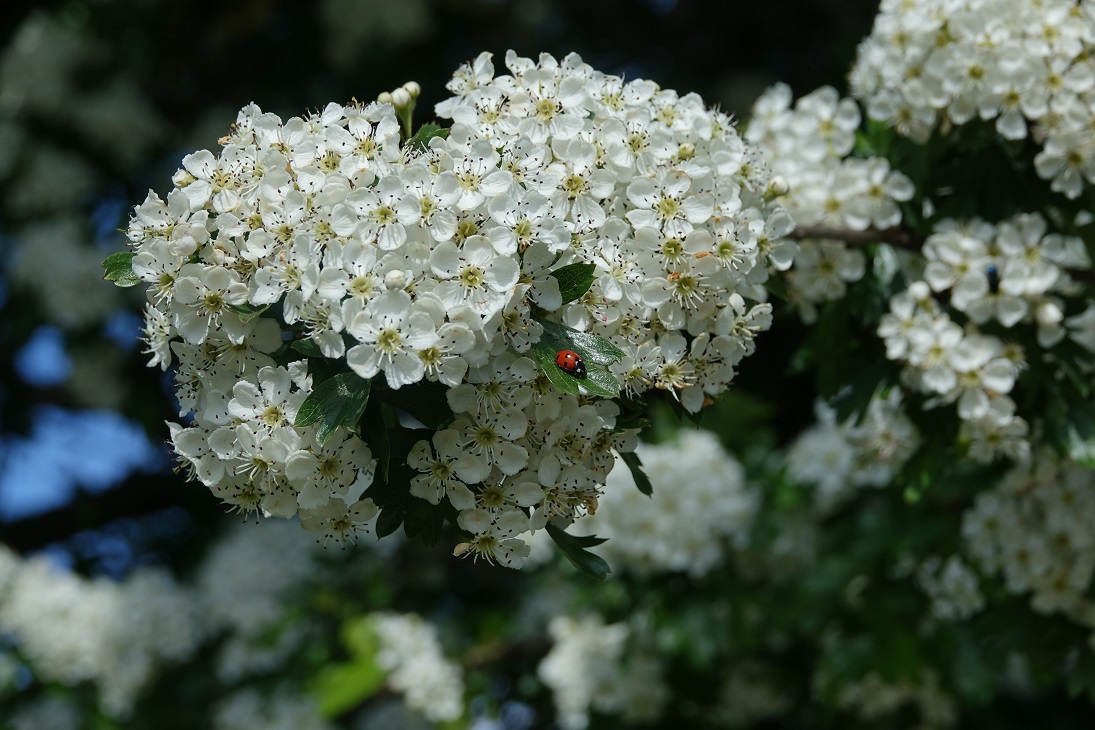

Swarm Arrival.
Things are warming up here in Nairnshire. Over the last week of May, temperatures have soared above 20 degrees Celsius. Hawthorn, Crataegus monogyna, is in full bloom and attracting a host of pollinators including honey bees, bumble bees and hover flies. Other flies are also attracted by the malodorous smell given off by this beautful tree. This is a clever pollination enhancing strategy and the odour is caused by the chemical trimethylamine which is one of the first products of putrefaction. Hawthorn needs ambient air temperatures of above 20 degrees C to yield nectar so we may be in luck around here this year. However, hawthorn is a fickle tree and I won’t hold my breath.
On Wednesday, it was 22 degrees C in the shade near the bee shed at 3:30 pm. I was pottering in the garden enjoying the heat and watching the bees coming in from working the last of the oil seed rape (OSR) which is quickly turning from vibrant dazzling yellow to green. As I was walking to the colonies in the back garden apiary, I heard the loud and familiar sound of a swarm above, and then from the west a cloud of bees flew in over the hedge. The bee-spangled sky darkened briefly as they jostled in the air on their way to my tree bait hive.


Bait Hive.
I could hardly contain my excitement. Usually I watch swarms leaving my hives but not arriving. I’d never seen a swarm arriving before and it was fascinating to get up close and watch them come in. Some milled around in the air for a bit while others lined up on the front of the hive looking like they needed a rest. Some foragers arrived with full pollen baskets and they all poured into the entrance. I saw a couple of drones only. They looked healthy bees and within half an hour they were all inside and sorting out the furniture in their new home. A couple of hours later foragers were back out in the field and bringing home OSR pollen.

Moving the Bait Hive.
Because this swarm orientated to the new hive and position almost immediately, they should have been moved over 3 miles away to a new location. This would have been ideal in terms of quarantining them and protecting my home colonies from disease. Had I been able to do this I would have moved them in the evening or early morning and then brought them back home in a couple of weeks. This being an extraordinary time, I had do the best I could without going anywhere. I needed to build up my apiary so chose not to give the swarm away which would have been another option in terms of moving them more than 3 miles. Because the bait hive was in a tree above the vegetable garden it would not have been convenient to bring the box down and move 3 feet a day to a new location. The obvious solution for the future, when I want to keep a swarm, is to position the bait hive where I want the colony to be.
In the late evening around 10pm when they were all home, I covered the entrance with mesh and watched my husband and son lift the box down from the stand in the tree and move it a few yards to my back lawn apiary. Next morning as predicted quite a few of the foragers returned to the bait hive tree position, but by late afternoon they had found their way back to the new home on the lawn. I’d spent most the day watching to see what would happen and was relieved to see them flying back.
Apart from adding some frames with undrawn foundation to fill the bait hive, I’ve left the swarm to settle but plan to move them over to the new residence after 3 days. I will sublimate using oxalic acid to kill the phoretic varroa mites before the first worker cell is capped after 9 days from egg laying.
Carol Gunn: Introduction.

Carol is from Caithness in the rugged far north of Scotland where there are not too many trees for swarms to cluster on. She has kept bees for a couple of years and her thirst for knowledge is unquenchable. Carol has travelled hundreds of miles over the last couple of years attending beekeeping courses from Elgin to Dumfries and places in between. Dumfries, near the border with England, is at the opposite end of Scotland from her home near John O’ Groats. Oh yes, and Carol works full time and runs 5 and 10 km runs when she’s not beekeeping.
Over to Carol and her Review of Penn State Extension online course Beekeeping 101
With the COVID 19 pandemic affecting folk across the world many organisations are offering special offers and promotions and one of these special promotions came from Penn State Extension which was offering free access to their On-line Beekeeping 101 course, aimed at new or prospective beekeepers and I thought I should investigate it as something positive to do during lockdown.
Whether to do the course or not was the subject of quite a few discussions on various FB pages with many novices looking for advice on whether this would be a good use of time.
As with everything beekeeping the opinions were wide and varied with quite a strong opposition to anything to do with American Beekeeping with warnings that their ways are so different to ours to well it looks interesting – as one not to miss a bargain I thought I would enrol and if it became too wacky I would just sign out and that would be the end of it.
It is all on-line with an expected duration of 9 hours and is presented by tutors Tom Butzler and Maryann Frazier, both experienced beekeepers and scientists. There is a mix of video clips and slides plus a “check your understanding” multiple-choice at the end of each section with an optional test at the end if you want to gain the course certificate.
The subjects covered were; Bee Biology; Equipment; Getting Started; Spring Management; Summer Management, Winter and Fall Management; Diseases and Pests; Honeybee Products and Pollination.
I found the whole course really interesting and yes there are differences but all fairly minor and certainly not of the mind poisoning variety, the focus unsurprisingly is on the Langstroth Hive which is fair enough with this being the main style used in the US, this is only a small percentage of the course content and is worth hearing about.
Bee biology; getting started; seasonal management; diseases and pests plus pollination was pretty standard information regardless of where you keep bees. Many of the key messages coming across were the same as I’ve heard on the “Healthy Bees” courses tutored by Ann and Tony here in Scotland – focus on keeping strong healthy colonies with a young queen; keep good tempered strains and renew the wax in your frames on a regular basis to minimise the presence of disease causing agents as well as minimising the build up of chemicals, including those applied by beekeepers. All sounds like good advice to me.
Some of the pests and diseases were more exotic than what we have here in the north of Scotland. Hearing how to deal with skunks and bears was interesting and is handy knowledge as I’ve come across a few of them in my day too….
Overall I found the course a good use of time, the tutors were both well informed, easy to follow and maybe better than that, they came across as pragmatic. I have gained new knowledge and will also try some new ideas, one of which is to use a good quality freezer bag as a syrup feeder. Use a cocktail stick to puncture the top of the bag 3 or 4 times see below.

I would definitely recommend the course, unfortunately the COVID special course fee waiver is currently over and there is now a fee of $39.75 which is still a 75% discount. For more information https://extension.psu.edu/beekeeping-101
Thank You to Carol.
I hope that you have enjoyed hearing about Carol’s course as much as I have. Thank you, Carol, for sharing your experiences with us.


Wonderful to be there at just the right moment. Doing swarm prevention/control but, for my own peculiar reasons, decided not to set out bait hives this year, or recover any swarms I lose – unless they’re bothering the neighbours. Timed an artificial swarm well though and now back up to four colonies.
Yes it was, Avery. Great that things are going well in your apiary. Now we want plenty rain in June to wet the heather’s feet!
Thank you for the Hawthorne information, it explains why you don’t get that distinctive honey every season, one of the best despite not caring for the smell of the plant. I also appreciate the diversity of American beekeeping culture which seems to be a reaction against, in many cases, the horrors of those commercial operations we have all heard about. Given the flood of cheap Chinese equipment now on the market and their immense production perhaps we should be seeking more information about their methods and strategies.
I’ve never had hawthorn honey, Tristan. Probably because OSR is always somewhere in a field near me at hawthorn flowering time. Have you had hawthorn honey? What is it like as I have only read about it in books as being dark?
I think it would be good if we produced more equipment in our own countries.
It’s been a few years since we had any and I don’t remember much about the colour. It is good.
Marvelous photos, Ann, of the swarm arriving and moving into your bait hive. This is something rarely photographed. I especially like how the arriving bees shine brightly against the dark background with the bait hive. Thank you!
Thank you for your comments, Tom. Linton took the photos and they are magnificent. The bees positively glittered in the sunlight on a golden afternoon. It is rare to have such a long stretch of lovely weather here in May in the north of Scotland